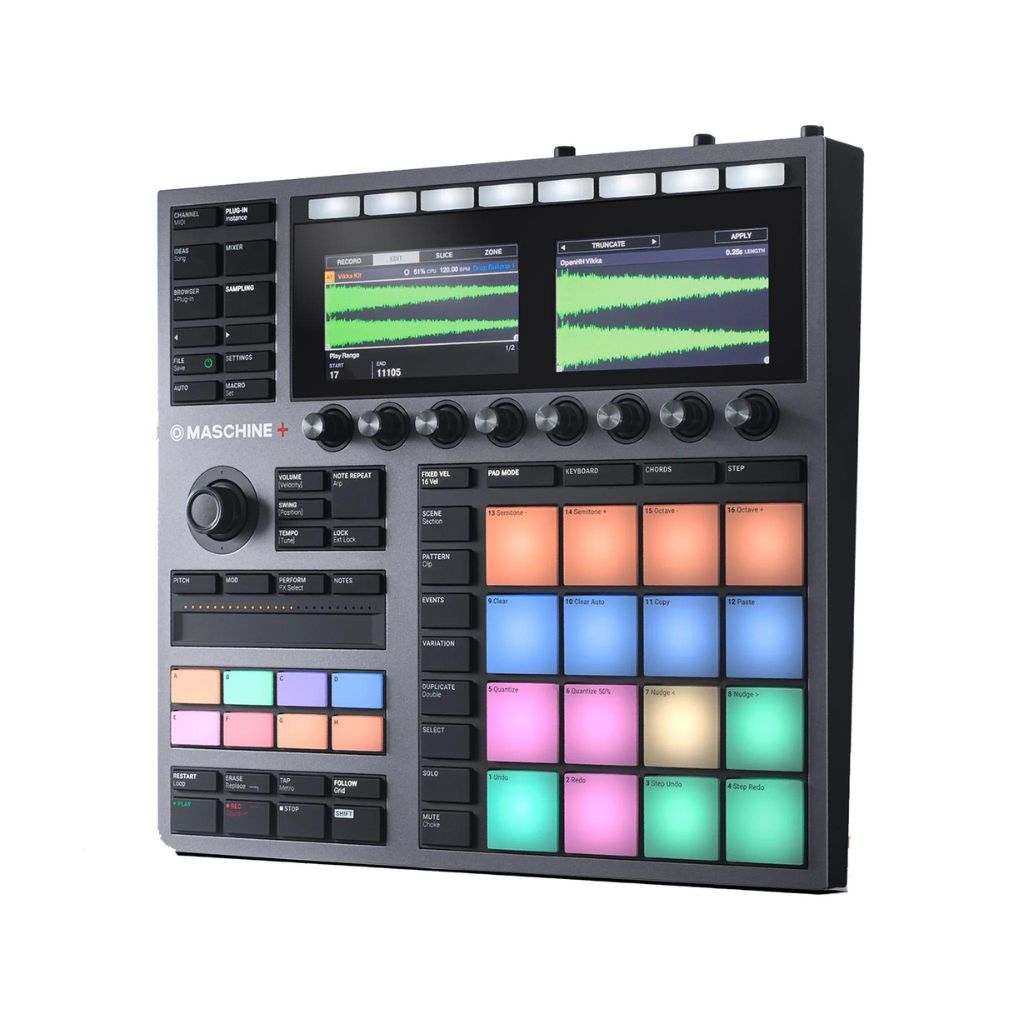The Big Review: Native Instruments Maschine+
Following a decade of widespread use and gradual evolution, NI’s Maschine has reached its logical conclusion in standalone form
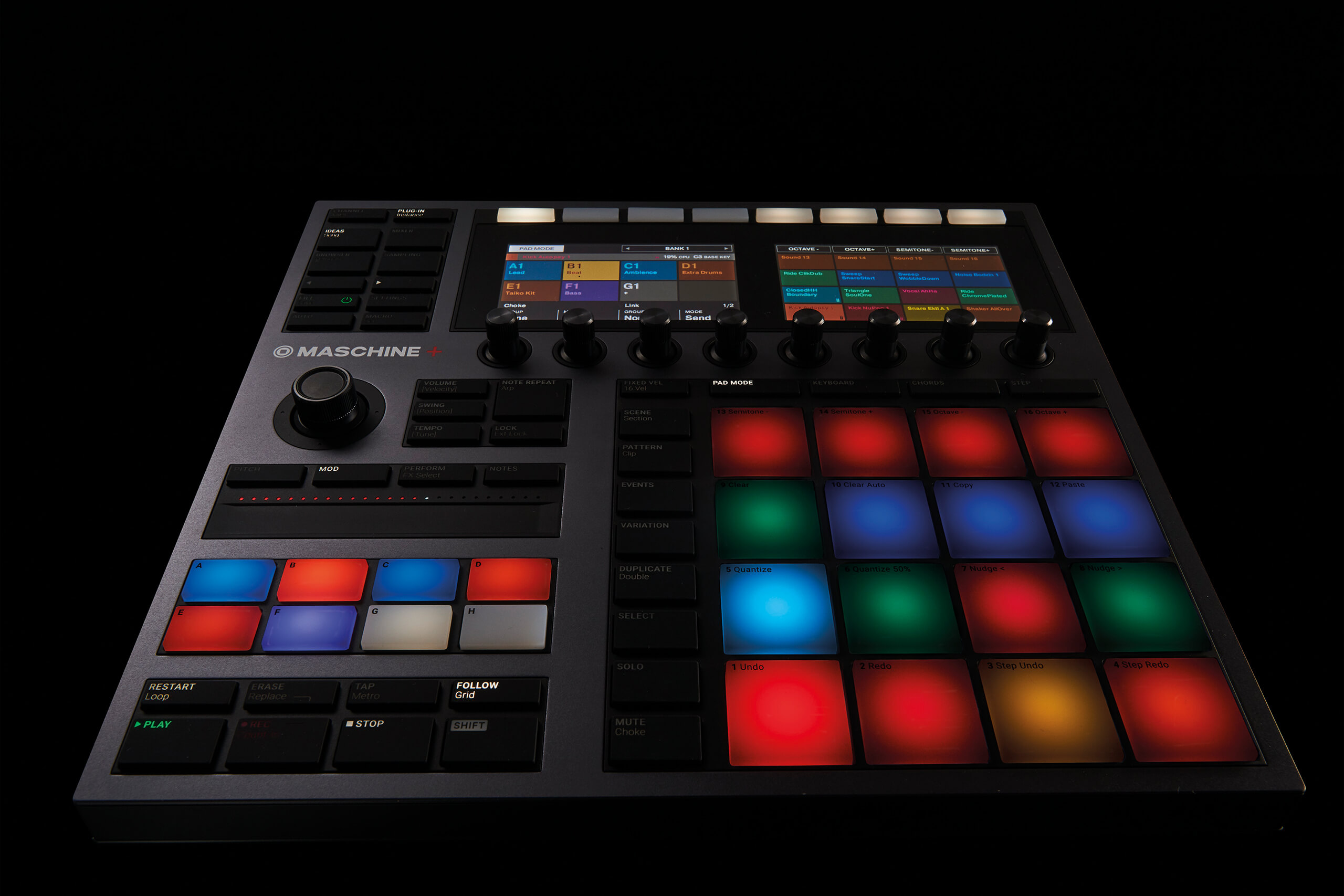
All images: Joesph Branston

Price £1,100
Contact Native Instruments
For a long time, this writer had an overly ambitious idea to take a small compact computer running Windows and get it to fit within the spacious Maschine Studio controller case. When the Maschine MK3 arrived on the scene, we soon forgot this plan in favour of the MK3’s smaller size and portability. The need behind this idea has of now been answered with the all-in-one Maschine+.
This writer first joined the Maschine platform at about software version 2.0, attracted by the potential for a 98 per cent hardware workflow, a workflow that was also unique to what we’d already established with the Ableton Push set-up. This was before the easier navigation of that came with colour LCD screens had arrived on the scene but creating a full song from an empty sketch pad was still possible on the earlier-generation monochrome displays. This is worthy of note as the discipline of not using your laptop keys or screen and focusing on a hardware workflow has become more widely popular now – and with good reason.
Visually, you can be presented with too much information when using a computer. Not only is there a wealth of music software options but you also have to be disciplined enough to steer yourself away from other computer-based distractions while working. Imposing constraints on yourself as an artist is a topic stressed by many great thinkers and it’s a real seed towards a more creative state of mind. As our own journey has taught us, the forced scenario of restricting your options can help you focus on making actual paintings instead of over-preparing with regard to how many colours you have and making sure you have brushes for every occasion. From the very outset, if you feel you want to work more with your ears over your eyes, and work more with your tools than your wallet, you’ll already find something that speaks to you here.
Who are you?
Depending on your preferences and music-making direction, you may have wildly different ideas as to what the benefits of Maschine are.There are those who have never used or witnessed Maschine in action, those who’ve used it enough to understand its workflow, and those already invested in another Maschine platform. Each group needs to ask itself whether they want to commit to hardware with their workflow (if they haven’t already). We also have two other categories to further divide us as music makers: are you intending to use this in the studio, for performing or both? It’s important to think of how integral you want this device to be to your set-up.
Hello to those of you who are new to Native Instruments’ whole Maschine concept – existing Maschine users already using the new version 2.12 of the software can skip this section. You may be awareof the Maschine controller and its custom software but here it’s time to explain the Maschine hierarchy to better understand how you’ll need to think to become a Maschine user. It was a new way of thinking for us too but, as with many of these things, once you’ve been able to memorise the processes involved here, using this unit will become a new language for sonic art and, as when learning new languages, you’ll soon find yourself thinking, creating and expressing yourself in new ways.

A whole new world
Maschine is a complete music-making software environment that’s is bundled
with your choice of Maschine hardware controller. You can run the software on its own or run one or more instances of the same software as a plug-in within another DAW. When you do this, the hardware uses an instances form of navigation so you can move from one instance to the next from the controller without having to touch your computer.
An example of this would be having a DAW project with an instance on different MIDI tracks – one instance for drums, another for melodic parts and the last for decorative sounds and sound effects. Now one plug-in instance could do all of this, as the standalone can, but for mental clarity, this is a popular choice.
Based around the 4×4 grid pads on the controller, all ideas start in an environment called Sounds. Sounds can be an audio sample on a pad, an instrument or the pad can be used for MIDI or audio input and output functions too. Each collection of 16 sounds (pads) is called a Group and these are navigated via the buttons of A through H on the left of the controller. Groups organise sounds of up to 16 at a time but they are also audio sub groups by default. Software version 2.12 boasts a new Clips feature, which is a step in the right direction.
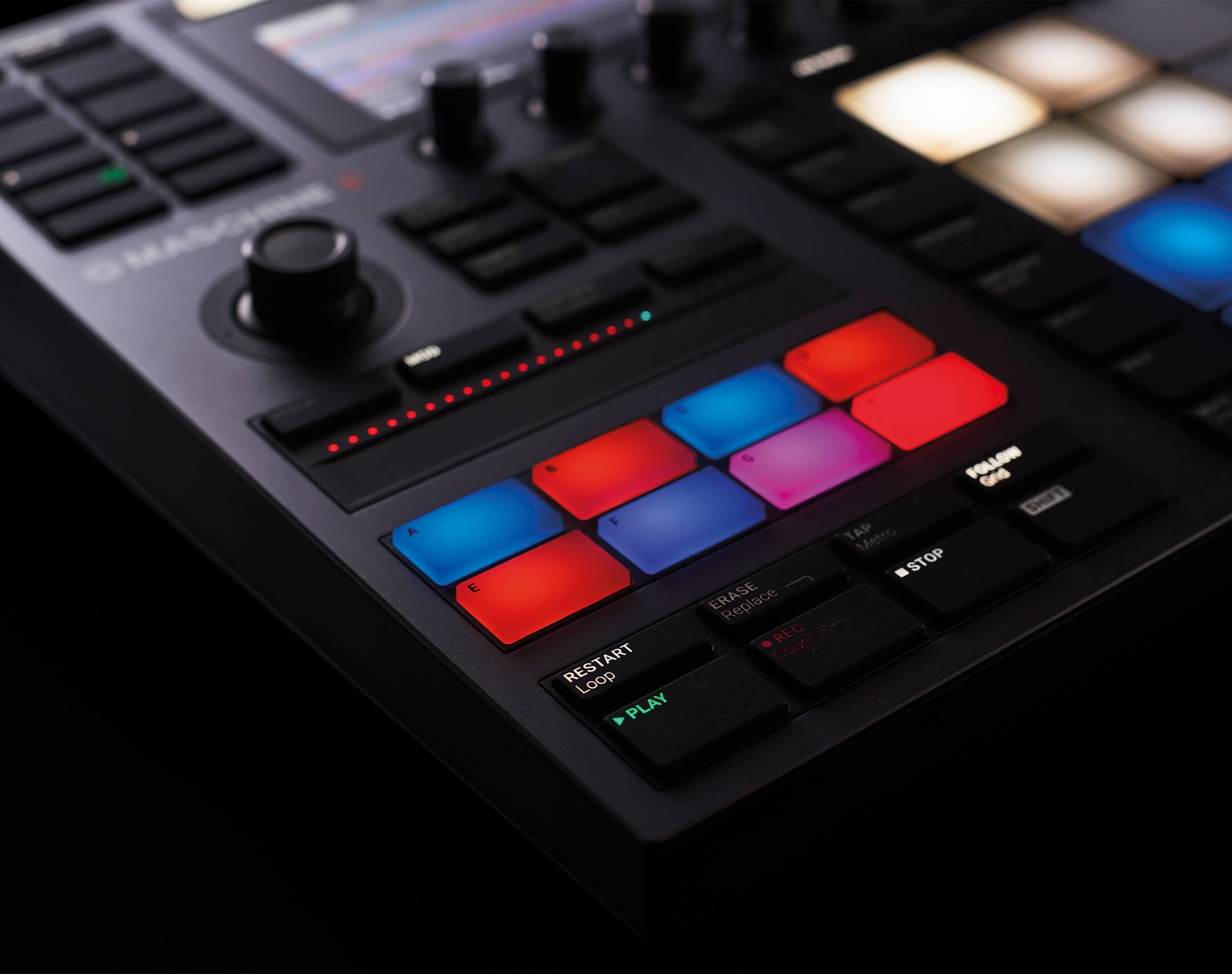
To sequence your music you have the option of using the audio plug-in, which can load audio loops and manipulate them using MIDI sequencing – they can run as loops or you can use MIDI notes to play their sound rhythmically, and the pitch of these notes can also repitch the audio. These unique approaches encourage unique ways of manipulating audio files.
The main and more historical option is to work in MIDI-event-based Patterns. These are collections of ideas or alternative ideas you can build up for each Group and store your combinations across the Groups in Scenes. If you use Ableton Live, that word should be familiar, and it references the same situation. They’re not stored visually in rows but you do use a collection of ideas and then sort musically into Scenes.
Once you have your scenes, you can start to sequence these in an Arrange View that looks similar to a traditional DAW’s linear arrangement process. But until now, it’s been restricted by this Pattern-based behaviour, making it hard to create edits directly on the Arrange page, and instead having to work quite hard on duplicating patterns and making your edits in there.
Clip it
Software version 2.12 boasts a new Clips feature, which is a step in the right direction towards using a traditional linear mindset to getting the final touches complete on a song. In opposition to Patterns, Clips can be used to start your ideas on the Arrange View or can be used to alter your more loop-based Pattern arrangements at any stage in the process.
You can now go from a great collection of ideas to a deeper, more engaging arrangement from start to finish at record speeds. Blank Clips can also be created and simply placed over your arranged Patterns for a quick and efficient way to create rests across your instrumentation.
Worth its weight
Our initial impression of this unit’s build quality was positive, thanks to its weight. The satisfying resistance when turning the knobs feels leagues ahead of the MK3. The whole unit feels like it has been created by an experienced hardware designer, and puts the comparatively weaker-looking MK3 unit to shame.
Registering the product via wifi is perhaps the only real time you’ll need to have a stable web connection – aside from updates and library downloading, you can forget that this is connected to the internet. There’s even an airplane mode, which we keep active unless we sync the unit to other gear via Ableton Link.
The pads feel superior to those on the MK3. Though there doesn’t seem to be a difference in the pads themselves. Rather, the whole resonance of the weightier materials used for the unit’s body makes them feel firmer by association, and the rebound feels better for this reason too.
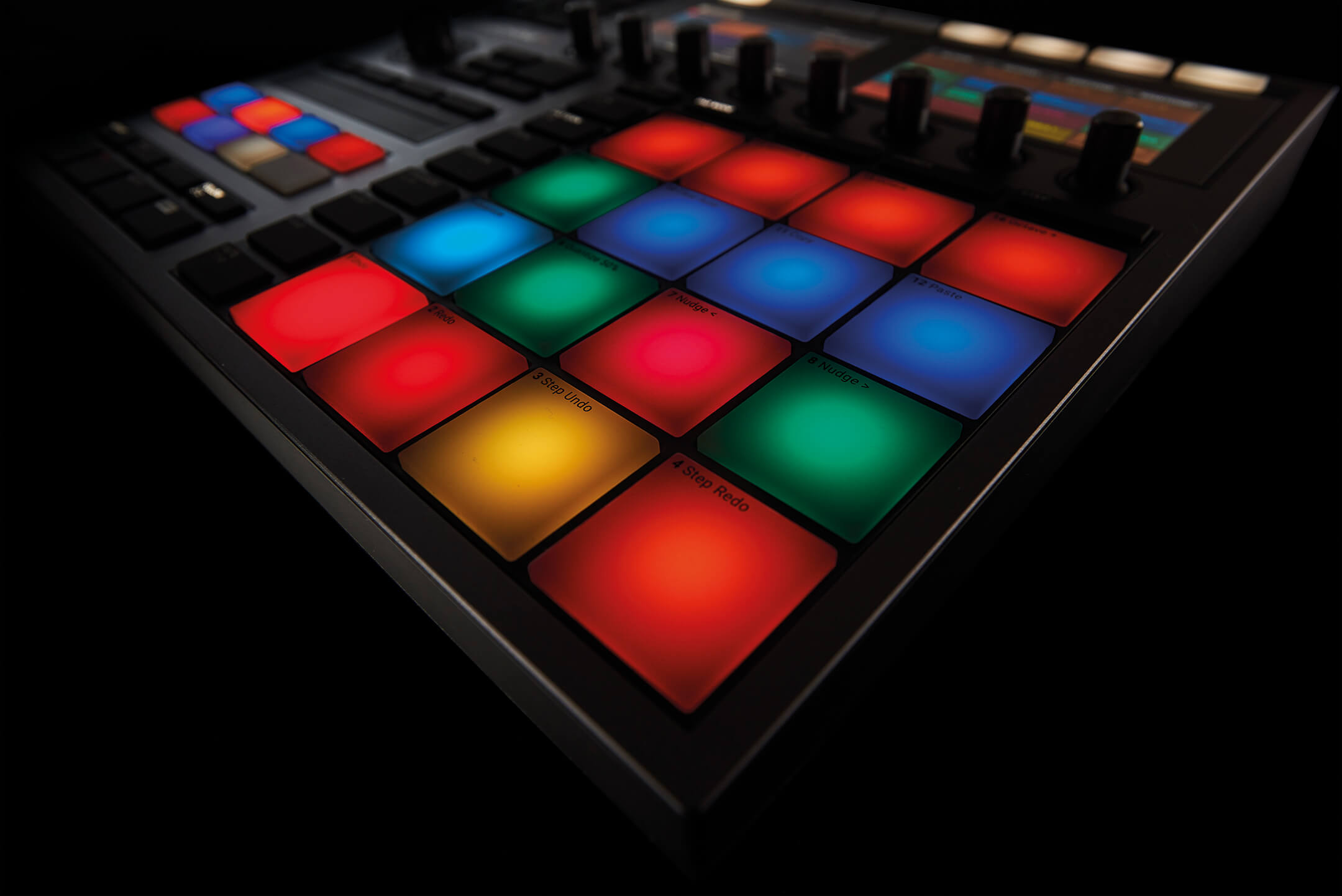
The software inside feels much the same as using an MK3-and-computer set-up. But the hardware feels great due to Maschine’s established approach to having the right amount of information on the LCDs. What is different is the omission of using third-party plug-ins. We understand this from Native’s point of view, as it’s the first phase of this new concept and it’s a wise decision to avoid the can of worms that is tools from other vendors and all the variables that could undermine stability. In terms of stability, the original software build immediately exposes some issues but Native fast-tracked a beta of the next update to us to complete this review and those key issues were resolved.
The rigidity of the base unit design also helps features such as the Smart Strips for Performance effects and modulation just feel better. We’re running the MK3 alongside the Maschine+ for comparison and, though it’s tricky to run a true blind test, the Maschine+ just feels better.
The only aspect of this unit that feels a little computer-like is the boot-up times. Shutdown takes about five seconds but boot-up takes about 19, which feels too slow for hardware in the studio.
Best wishes
After many hours of turning this unit on and off, and creating music using a host of set-up options, the Maschine+ has found a home in our studio. After auditioning multiple configurations, we settle on running the unit as a complementary sound canvas along with Ableton Live’s own particular tone of library via Ableton Link, and will continue to do so. But the option to power-up the Maschine+ before your computer makes it feel more like a tool with purpose. Ableton Link works flawlessly but you’re limited to using this only over wifi – a hard-wired network connection could be useful in a live situation, maybe via the USB to a computer connection?
Working with the Maschine+ using its internal range of instruments, processing, routing and large range of library presets is an enjoyable experience and lets you get your ideas down fast. Presets can be imported, as can your own audio samples via the SD card. But this could be improved upon. Again, a USB-to-computer connection would be the answer.
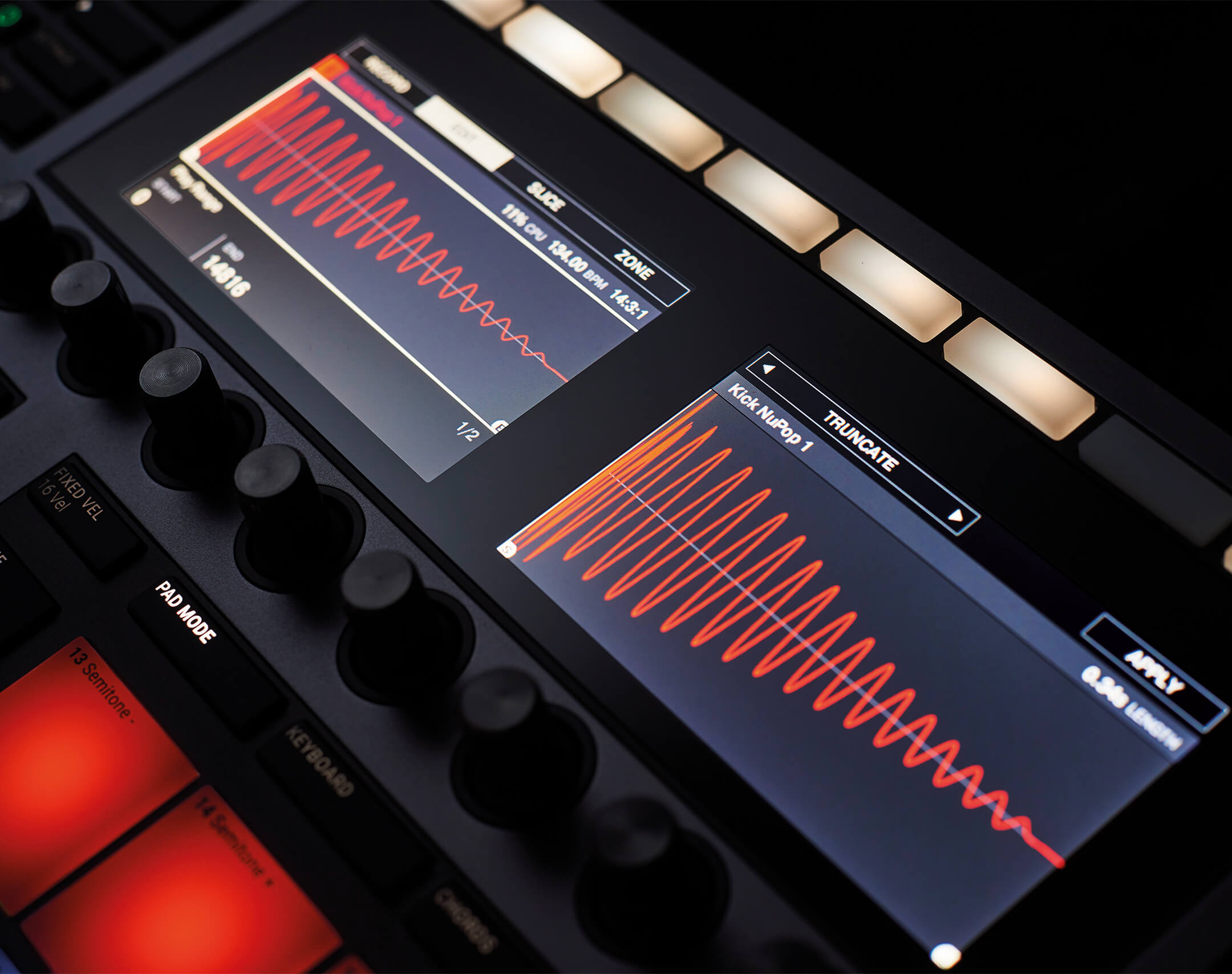
MIDI clock and external MIDI gear gives mixed results. Running a standalone DrumBrute Impact as the main clock source with the Maschine+ offset with a negative delay to get the beats between both machines aligned works just fine. But when using he Maschine+ as the clock source, you can’t pre-send a MIDI clock to other gear to get the same level of tightness. Native has said, based on user requests, that this is something they could potentially implement. We’d welcome it.
Running the audio from the DrumBrute into the Maschine environment works well, and with the supported NI Audio 6 interface, the additional audio I/O available lets you set up insert and/or auxiliary processing with external hardware, a boon for both studio and live performance use.
At the time of writing, our Motu MIDI Express 128 interface will not add additional MIDI I/O to the equation but, again, Native has stressed that it plans to support class-compliant MIDI interfaces in the future.
Third-party audio interfaces look less likely to get future support but, again, perhaps a concerted effort on the part of users would help encourage this. A larger audio I/O could open this product up much more, and help it become a hub with which to control much more external hardware. A larger MIDI I/O, for example, could sequence many external instruments and be used to feed a MIDI clock to CV converter and let people integrate CV gear. But for that, we’d need more audio inputs on an external mixer.
The future for the software side of this unit points towards more options in terms of the traditional arranging of ideas. In time, the excellent lock-states parameter feature could shift from an excellent parameter-morphing performance tool to something that could be captured and become a permanent part of your compositions.
These are early days for this product and using it has been a wholly positive experience despite the handful of teething troubles. If you feel the need to have more than a 4×4 pad-based expression, you can use additional MIDI controllers as keyboards etc. But when you throw your hat into the standalone-hardware ring, the potential user base’s requirements for more options and expansions open up and must be catered for as the product continues to evolve. With the new software features here, the workflow now makes greater sense than ever, elevating this generation of Maschine above its predecessors into an all-round mature platform for studio and/or performance work.
Overview
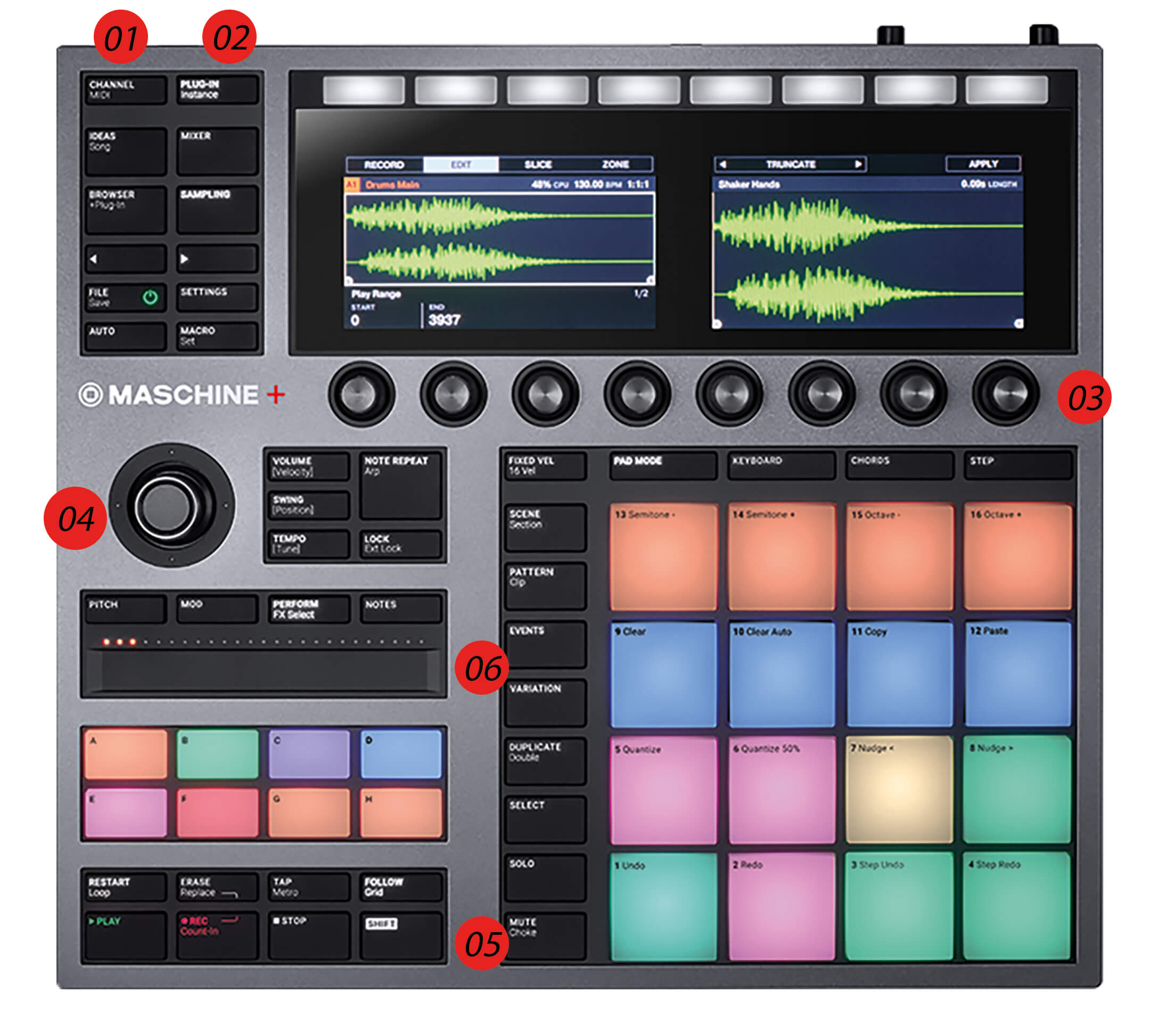
1. At the rear are two USB ports for external devices, alongside a connection to use the
unit as a USB-powered controller with your computer. USB hard drives will receive support in the future.
2. The power connection has a twist-to-lock function to avoid the accidental loss of power from unexpected disconnection, from user error or when you rock the crowd too much.
3. Navigating the display screen parameters via the Maschine+’s weighty encoders feels more sastisfying and luxurious compared to MIDI-controller-based models.
4. The 4D Push encoder can be rotated, pushed and directionally clicked like a joystick. Not only does this speed up navigation, it’s also a blessing when it comes to naming and saving within the software via an onscreen keyboard.
5. The new Clip functionality is available via a new Shift+Pattern function. From here you can create, duplicate, modify and clear enough unique clips for your linear arrangement workflow.
6. The Smart Strip can be controlled subtly by placing your finger down and angling it, sliding across, or you can hold one side and tap the other with another finger for rapid rhythmic results.
Do I really need this?
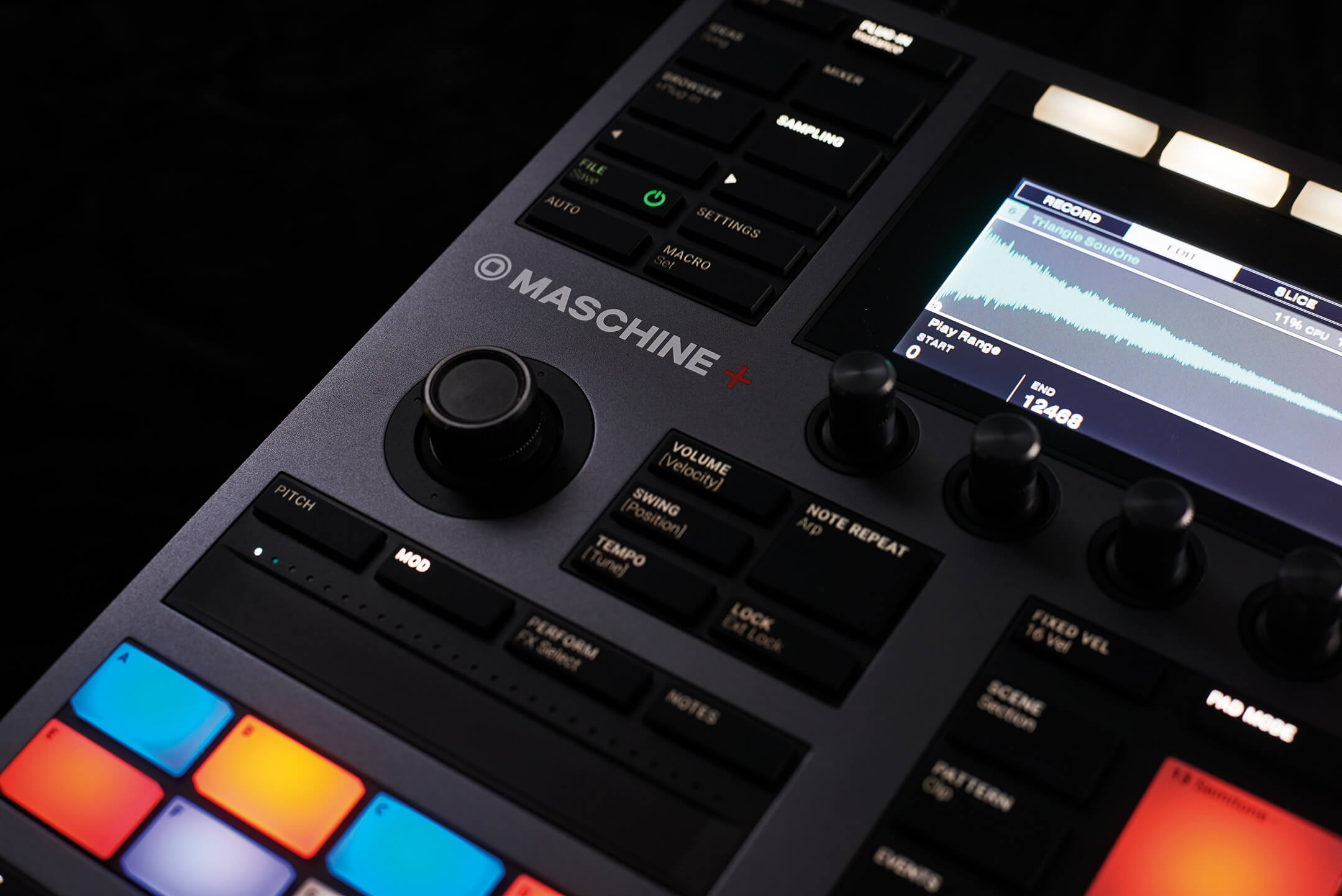
In the studio and for live performance, for ITH (in-the-hardware) compositions and performing, you can expect the same workflow experience from the Maschine. When you want to expand to cater for more gear, Ableton Link is the perfect method. But until we get the option of a generous audio I/O via adding a higher spec audio interface, you’ll always need a means to sum together various audio sources through a mixer or another device with more inputs.
The MIDI-sync options can work well enough but with the lack of MIDI clock out negative offset, you are limited to how well you can get everything to align. If you’re just looking for a computer-free solution for fun and fluid music-making, then the Maschine+ is surely set to become the new benchmark.The new movement between the Pattern and Clip editor is another workflow to memorise and embed in your psyche but it feels natural quite quickly.
Key features
- Sturdy hardware build and feel
- Solid software workflow
- Support for certain external devices
- High-quality range of instruments
- 64GB SD Card can be upgraded without limit
- FM8, Massive, Prism, Monark, Raum, Bass Synth and Phasis plug-ins
Alternatives
With an 8×8 pad layout, the Force can work with samples, audio files and instruments, plus you get Splice integration. The pads are a different form of expression but the notes and sounds available is far greater.
Elektron
Octatrack II £1,130
A departure from the DAW-like features of the Force and the Maschine+, this unit focuses on sample/audio manipulation and offers ways to get your hands extremely deep into your sounds.
